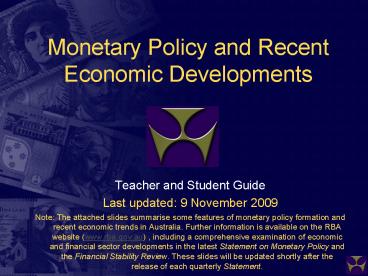Monetary Policy and Recent Economic Developments - PowerPoint PPT Presentation
1 / 35
Title:
Monetary Policy and Recent Economic Developments
Description:
... (www.rba.gov.au) , including a comprehensive examination of economic ... the Bank's policy on all other matters, except payments system policy (addressed ... – PowerPoint PPT presentation
Number of Views:32
Avg rating:3.0/5.0
Title: Monetary Policy and Recent Economic Developments
1
Monetary Policy and Recent Economic Developments
- Teacher and Student Guide
- Last updated 9 November 2009
- Note The attached slides summarise some features
of monetary policy formation and recent economic
trends in Australia. Further information is
available on the RBA website (www.rba.gov.au) ,
including a comprehensive examination of economic
and financial sector developments in the latest
Statement on Monetary Policy and the Financial
Stability Review. These slides will be updated
shortly after the release of each quarterly
Statement.
2
Reserve Bank of Australia
- Responsible for
- Monetary policy
- Payments system stability efficiency
- Financial system stability
- Issuing Australias currency notes
- Banker to the government
- Managing foreign exchange reserves
3
Reserve Bank Board
- Responsible for
- - the Banks monetary and banking policy
- - the Banks policy on all other matters, except
payments system policy (addressed by the Payments
System Board) - Nine members Governor, Deputy Governor,
Secretary to the Treasury and six external
members - Meets first Tuesday each month, except January
4
Objectives of Monetary Policy
- The objectives specified in the Reserve Bank Act
(1959) are - Stability of the currency
- Maintenance of full employment
- Economic prosperity and welfare of the people of
Australia
5
How does the RBA achieve its objectives?
- By maintaining a steady and low inflation rate,
consumers and producers can efficiently respond
to relative price movements - The RBA adopted an inflation targeting regime in
1993, which was formalised in an agreement with
the government in 1996, and updated in 2003, 2006
and 2007 - The price objective is to keep annual inflation
between 2 and 3 per cent, on average, over the
cycle - While CPI inflation is the target, various
underlying measures which abstract from
temporary large price increases and decreases
help discern future trends in CPI (or headline)
inflation
6
How does the RBA affect inflation?
- The RBA Board sets the policy interest rate
(termed the cash rate the rate banks charge
each other for overnight funds) and uses its
liquidity operations to achieve this rate - Changes in the cash rate affect mortgage and
other lending and deposit rates in the economy - Changes in these interest rates, along with any
exchange rate response, in turn affect the level
of private consumption and investment - Over time inflation is likely to be steady and
low when total spending is kept close to the
level of output
7
Global environment
8
(No Transcript)
9
(No Transcript)
10
(No Transcript)
11
(No Transcript)
12
(No Transcript)
13
(No Transcript)
14
(No Transcript)
15
(No Transcript)
16
(No Transcript)
17
Domestic Activity
18
(No Transcript)
19
(No Transcript)
20
(No Transcript)
21
(No Transcript)
22
(No Transcript)
23
(No Transcript)
24
(No Transcript)
25
(No Transcript)
26
(No Transcript)
27
(No Transcript)
28
Price Pressures
29
(No Transcript)
30
(No Transcript)
31
(No Transcript)
32
Policy Response
33
(No Transcript)
34
(No Transcript)
35
For more information . . .
- RBA website (http//www.rba.gov.au/ )
- Chart Pack (updated monthly)
- Education
- Statistics































